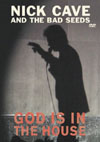 As the cost of technology comes down consistently, it's puzzling to
note that few labels are taking advantage of the marvelous
opportunities before them. This is a fantastic example of a music DVD
done properly, despite it being a few years after the album release of No More Shall We Part.
Most of the material comes from that album, but considering other live
videos available from the Bad Seeds, it serves as a fine addition to
the library. Here, the Bad Seeds are captured at a concert in Lyon,
France (2001). It just happens to be the last tour that Neubauten's
Blixa Bargeld is supposed to perform on and here, he, along with Mick
Harvey and Dirty Three's Warren Ellis are just as entertaining to watch
as Nick Cave, himself. Cave may not quite ever become a household name
but he is most certainly becoming a musical legend. Cave's ballads
speak volumes and his stage presence is intense, much like an
evangelical preacher. The experience of seeing the Bad Seeds live is so
intense and dramatic, that it blows away all expectations from merely
listening to the records at home. Even a lukewarm album can achieve a
thunderous accomplishment as the Bad Seeds are all fantastic players
and spend so much time touring. The concert is elegantly shot and
edited with a good amount of inclusion of the entire group, and the
sound is excellent. In addition, Mute thankfully decided not to hold
back on this release and included all three music videos from the album
along with a short documentary on the recording of the album. Coupled
with the album and the experience is complete. I can hope that it's
only a matter of time that labels will release DVDs like this WITH the
CD of said album. (But in all honesty, expect it to be a Japanese
"perk" for about 10 years before the rest of the world catches on.)
As the cost of technology comes down consistently, it's puzzling to
note that few labels are taking advantage of the marvelous
opportunities before them. This is a fantastic example of a music DVD
done properly, despite it being a few years after the album release of No More Shall We Part.
Most of the material comes from that album, but considering other live
videos available from the Bad Seeds, it serves as a fine addition to
the library. Here, the Bad Seeds are captured at a concert in Lyon,
France (2001). It just happens to be the last tour that Neubauten's
Blixa Bargeld is supposed to perform on and here, he, along with Mick
Harvey and Dirty Three's Warren Ellis are just as entertaining to watch
as Nick Cave, himself. Cave may not quite ever become a household name
but he is most certainly becoming a musical legend. Cave's ballads
speak volumes and his stage presence is intense, much like an
evangelical preacher. The experience of seeing the Bad Seeds live is so
intense and dramatic, that it blows away all expectations from merely
listening to the records at home. Even a lukewarm album can achieve a
thunderous accomplishment as the Bad Seeds are all fantastic players
and spend so much time touring. The concert is elegantly shot and
edited with a good amount of inclusion of the entire group, and the
sound is excellent. In addition, Mute thankfully decided not to hold
back on this release and included all three music videos from the album
along with a short documentary on the recording of the album. Coupled
with the album and the experience is complete. I can hope that it's
only a matter of time that labels will release DVDs like this WITH the
CD of said album. (But in all honesty, expect it to be a Japanese
"perk" for about 10 years before the rest of the world catches on.) As the cost of technology comes down consistently, it's puzzling to
note that few labels are taking advantage of the marvelous
opportunities before them. This is a fantastic example of a music DVD
done properly, despite it being a few years after the album release of No More Shall We Part.
Most of the material comes from that album, but considering other live
videos available from the Bad Seeds, it serves as a fine addition to
the library. Here, the Bad Seeds are captured at a concert in Lyon,
France (2001). It just happens to be the last tour that Neubauten's
Blixa Bargeld is supposed to perform on and here, he, along with Mick
Harvey and Dirty Three's Warren Ellis are just as entertaining to watch
as Nick Cave, himself. Cave may not quite ever become a household name
but he is most certainly becoming a musical legend. Cave's ballads
speak volumes and his stage presence is intense, much like an
evangelical preacher. The experience of seeing the Bad Seeds live is so
intense and dramatic, that it blows away all expectations from merely
listening to the records at home. Even a lukewarm album can achieve a
thunderous accomplishment as the Bad Seeds are all fantastic players
and spend so much time touring. The concert is elegantly shot and
edited with a good amount of inclusion of the entire group, and the
sound is excellent. In addition, Mute thankfully decided not to hold
back on this release and included all three music videos from the album
along with a short documentary on the recording of the album. Coupled
with the album and the experience is complete. I can hope that it's
only a matter of time that labels will release DVDs like this WITH the
CD of said album. (But in all honesty, expect it to be a Japanese
"perk" for about 10 years before the rest of the world catches on.)
As the cost of technology comes down consistently, it's puzzling to
note that few labels are taking advantage of the marvelous
opportunities before them. This is a fantastic example of a music DVD
done properly, despite it being a few years after the album release of No More Shall We Part.
Most of the material comes from that album, but considering other live
videos available from the Bad Seeds, it serves as a fine addition to
the library. Here, the Bad Seeds are captured at a concert in Lyon,
France (2001). It just happens to be the last tour that Neubauten's
Blixa Bargeld is supposed to perform on and here, he, along with Mick
Harvey and Dirty Three's Warren Ellis are just as entertaining to watch
as Nick Cave, himself. Cave may not quite ever become a household name
but he is most certainly becoming a musical legend. Cave's ballads
speak volumes and his stage presence is intense, much like an
evangelical preacher. The experience of seeing the Bad Seeds live is so
intense and dramatic, that it blows away all expectations from merely
listening to the records at home. Even a lukewarm album can achieve a
thunderous accomplishment as the Bad Seeds are all fantastic players
and spend so much time touring. The concert is elegantly shot and
edited with a good amount of inclusion of the entire group, and the
sound is excellent. In addition, Mute thankfully decided not to hold
back on this release and included all three music videos from the album
along with a short documentary on the recording of the album. Coupled
with the album and the experience is complete. I can hope that it's
only a matter of time that labels will release DVDs like this WITH the
CD of said album. (But in all honesty, expect it to be a Japanese
"perk" for about 10 years before the rest of the world catches on.) As principal early players in the '90s computer music scene, fetishising digital audio and austere CGI graphics with the best of them, it's fitting that Farmers Manual should be behind RLA, the latest and most uncompromising expression so far of the Merzbox mentality. Technically, RLA is a dual layer DVD9, NTSC, region-free DVD with a running time of three days, 21 hours and 38 seconds. It's as exhaustive as possible a collection of everything to do with Farmers Manual's live shows since 1995: nearly four days of MP3s (from "several artists, but mostly FM and related folks") along with accompanying JPEGs of the shows, their locations, gig flyers, stage passes, press reviews, mailing list write-ups, and even a few movie files. The icing on the cake is that, inserted in a computer's DVD drive, it auto-plays some baffling and unexplained handheld camcorder footage of FM knocking a wall down in a basement studio, then later hanging around in an apartment with a cat.
As principal early players in the '90s computer music scene, fetishising digital audio and austere CGI graphics with the best of them, it's fitting that Farmers Manual should be behind RLA, the latest and most uncompromising expression so far of the Merzbox mentality. Technically, RLA is a dual layer DVD9, NTSC, region-free DVD with a running time of three days, 21 hours and 38 seconds. It's as exhaustive as possible a collection of everything to do with Farmers Manual's live shows since 1995: nearly four days of MP3s (from "several artists, but mostly FM and related folks") along with accompanying JPEGs of the shows, their locations, gig flyers, stage passes, press reviews, mailing list write-ups, and even a few movie files. The icing on the cake is that, inserted in a computer's DVD drive, it auto-plays some baffling and unexplained handheld camcorder footage of FM knocking a wall down in a basement studio, then later hanging around in an apartment with a cat.
 Mike Patton has a cult fanbase, mostly due to his vocal gymnastics andhis unique sensibilities when fronting a group — c.f. Fantomas, Mr.Bungle, et al — but with Tomahawk he's very much in Rock Band Membermode, not acting as the circus ringleader. This can be a great thing,as the new Tomahawk album shows. The first Tomahawk album was full of aviolent starts and sudden stops but Mit Gasis a 40 minute sampling of smoother (if still bizarre) Tomahawk pieces.Band leader Duane Dennison (Jesus Lizard) continues to lay down acollection of sneaky guitar riffs and licks over the thick, solidlayers of drums and bass guitar. The album's opener, "Birdsong," beginswith imposing bass drones, ominous slide guitar notes and birdsongsamples until a minute in, when the bass comes in and lays the albumbare as a rock and roll record. The guitar sounds sparse throughout therecord, with judicious use of effects and guitar wankery and a fewelectronic sounds for texture. The combination of the guitar's timbreand the band's rocking gives the record an immediacy that I haven'theard in a lot of recent "rock" music. The album has lots of highpoints, and comes across as more comfortable and cohesive thanTomahawk's debut album. There's no doubt that playing live has made theband members more comfortable with each other. There are moments offunkiness, like the wicked "Harelip" with its funky bass and slinkyguitar and Patton's comic crooning "I am the Harelip/Give me one morekiss," and right between the jittering electronic "Capt. Midnight" withits bombastic bridge and guitar that belongs in a David Lynch movie.The pounding "When The Stars Begin To Fall" is followed by the soothingballad "Desastre Natural," equipped with accusatory lyrics sung inspanish. The album comes to an end with "Harem Clowns" and "Aktion13F14." The former is a moody instrumental which features a sampled andrepeated phrase, "I don't know how to read notes," over and over again.It leads into the latter, where a robotic voice reads hand-to-handcombat "how-to" instructions over a hypnotic bassline. Everythingeventually collapses into a clusterfuck of noise followed by a silenceand a beautiful short guitar piece. Fading into nothing is a perfectway to finish off an album with so many peaks. -
Mike Patton has a cult fanbase, mostly due to his vocal gymnastics andhis unique sensibilities when fronting a group — c.f. Fantomas, Mr.Bungle, et al — but with Tomahawk he's very much in Rock Band Membermode, not acting as the circus ringleader. This can be a great thing,as the new Tomahawk album shows. The first Tomahawk album was full of aviolent starts and sudden stops but Mit Gasis a 40 minute sampling of smoother (if still bizarre) Tomahawk pieces.Band leader Duane Dennison (Jesus Lizard) continues to lay down acollection of sneaky guitar riffs and licks over the thick, solidlayers of drums and bass guitar. The album's opener, "Birdsong," beginswith imposing bass drones, ominous slide guitar notes and birdsongsamples until a minute in, when the bass comes in and lays the albumbare as a rock and roll record. The guitar sounds sparse throughout therecord, with judicious use of effects and guitar wankery and a fewelectronic sounds for texture. The combination of the guitar's timbreand the band's rocking gives the record an immediacy that I haven'theard in a lot of recent "rock" music. The album has lots of highpoints, and comes across as more comfortable and cohesive thanTomahawk's debut album. There's no doubt that playing live has made theband members more comfortable with each other. There are moments offunkiness, like the wicked "Harelip" with its funky bass and slinkyguitar and Patton's comic crooning "I am the Harelip/Give me one morekiss," and right between the jittering electronic "Capt. Midnight" withits bombastic bridge and guitar that belongs in a David Lynch movie.The pounding "When The Stars Begin To Fall" is followed by the soothingballad "Desastre Natural," equipped with accusatory lyrics sung inspanish. The album comes to an end with "Harem Clowns" and "Aktion13F14." The former is a moody instrumental which features a sampled andrepeated phrase, "I don't know how to read notes," over and over again.It leads into the latter, where a robotic voice reads hand-to-handcombat "how-to" instructions over a hypnotic bassline. Everythingeventually collapses into a clusterfuck of noise followed by a silenceand a beautiful short guitar piece. Fading into nothing is a perfectway to finish off an album with so many peaks. - samples:
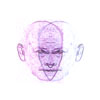 For an album that is right at forty-six minutes long, it sure does seemto last an enternity. The entire record is basically a series of tonesaccompanied by various passages concerned with or describing sexualperversions. At first this seemed like an exciting enough prospect:Andrew Liles associates Aural Anagramwith the various productions of Hans Bellmer. Bellmer was one of thefirst post-Dada surrealists, his self-portrait appears on the cover andI assume that the artwork in the liner notes is either inspired ordrawn by him. The primary sketch on the liner notes depicts a nudewoman on her hands and knees with her lower torso "x-rayed" to revealher womb and sexual organs. At the same time, she is pleasuring threedifferent men who are shown only by the presence of their penis. It's astrange image to be sure, but none of the sexuality in the picturemakes it into the music in any way. Each track sounds remarkably thesame with various vocal samples describing various perversities orsexual observations made from a nearly medical standpoint. Nothingchanges throughout the duration of the recording: many of the tonesused have the same color and feel throughout and much of the vocalsamples simply repeat themselves into boring oblivion. It sounds morelike one long recording than a series of nine compositions inspired byan explicit artist. It may be my hormones talking, but with a premisslike this, the album certainly could've been more exciting and retainedits rather dark and ominous atmosphere. In the end, that is what makeseverything about this recording so dull: it's too dark for too long andwith little to no variation in the bleakness of it all. It's aninteresting exploration of an artist and an idea but it fails as acomposition as a result of being far too limited in scope.
For an album that is right at forty-six minutes long, it sure does seemto last an enternity. The entire record is basically a series of tonesaccompanied by various passages concerned with or describing sexualperversions. At first this seemed like an exciting enough prospect:Andrew Liles associates Aural Anagramwith the various productions of Hans Bellmer. Bellmer was one of thefirst post-Dada surrealists, his self-portrait appears on the cover andI assume that the artwork in the liner notes is either inspired ordrawn by him. The primary sketch on the liner notes depicts a nudewoman on her hands and knees with her lower torso "x-rayed" to revealher womb and sexual organs. At the same time, she is pleasuring threedifferent men who are shown only by the presence of their penis. It's astrange image to be sure, but none of the sexuality in the picturemakes it into the music in any way. Each track sounds remarkably thesame with various vocal samples describing various perversities orsexual observations made from a nearly medical standpoint. Nothingchanges throughout the duration of the recording: many of the tonesused have the same color and feel throughout and much of the vocalsamples simply repeat themselves into boring oblivion. It sounds morelike one long recording than a series of nine compositions inspired byan explicit artist. It may be my hormones talking, but with a premisslike this, the album certainly could've been more exciting and retainedits rather dark and ominous atmosphere. In the end, that is what makeseverything about this recording so dull: it's too dark for too long andwith little to no variation in the bleakness of it all. It's aninteresting exploration of an artist and an idea but it fails as acomposition as a result of being far too limited in scope. samples:
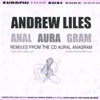 On the other hand, the remix album included with the first one-hundred copies of Aural Anagramis a more cohesive, varied, and interesting exploration of droningsounds and sexual expression. Instead of being a series of nine trackslike the original was, Anal Aura Gram is four tracks tiedtogether very closely so that the recording can be experienced as awhole. By cutting the album down by ten minutes and condensing much ofthe original material, Liles creates an almost deafening world. Itisn't deafening because it's overly loud or overpowering in any way,it's just that the sounds used produce the aural equivalent ofclaustrophobia. Every sound has a tactitle quality, whether it isfeathery softness or the cold feeling of making a discomfortingobservation. More melodic elements are present than on the original andnot so much time is devoted to near-silence or frustrating repetition.The vocal samples are used more sparingly and multiple textures areused throughout so that nothing overstays its welcome. This sort ofattention to detail adds to the eerie and dire feelings that wereattempted on the original mix: various melodic tones float like bubblesand are flourished by rolling sparkles in piano-like ascents anddescents. Small buzz-saws cut away quietly in the background whileother alien sounds stutter and chop their away across the soundspectrum. Here and there feminine moans and abrupt cries appear anddisappear within the mix creating a vaguely erotic tension whilemaintaining a secretive tone that hints at violence, destruction, and(somehow) infidelity. There are fewer overtly sexual references made,but the ones used are both exciting and unsettling. The remixes areeverything Aural Anagram could've (and should've) been, so those interested should grab a copy before they all disappear.
On the other hand, the remix album included with the first one-hundred copies of Aural Anagramis a more cohesive, varied, and interesting exploration of droningsounds and sexual expression. Instead of being a series of nine trackslike the original was, Anal Aura Gram is four tracks tiedtogether very closely so that the recording can be experienced as awhole. By cutting the album down by ten minutes and condensing much ofthe original material, Liles creates an almost deafening world. Itisn't deafening because it's overly loud or overpowering in any way,it's just that the sounds used produce the aural equivalent ofclaustrophobia. Every sound has a tactitle quality, whether it isfeathery softness or the cold feeling of making a discomfortingobservation. More melodic elements are present than on the original andnot so much time is devoted to near-silence or frustrating repetition.The vocal samples are used more sparingly and multiple textures areused throughout so that nothing overstays its welcome. This sort ofattention to detail adds to the eerie and dire feelings that wereattempted on the original mix: various melodic tones float like bubblesand are flourished by rolling sparkles in piano-like ascents anddescents. Small buzz-saws cut away quietly in the background whileother alien sounds stutter and chop their away across the soundspectrum. Here and there feminine moans and abrupt cries appear anddisappear within the mix creating a vaguely erotic tension whilemaintaining a secretive tone that hints at violence, destruction, and(somehow) infidelity. There are fewer overtly sexual references made,but the ones used are both exciting and unsettling. The remixes areeverything Aural Anagram could've (and should've) been, so those interested should grab a copy before they all disappear.samples:
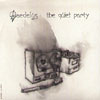 The Quiet Party is a re-mix EP of tracks from Los Angeles avant-garde hip hop producer Daedelus' Inventiondisc, including interpretations from the good company of producer/DJMadlib, the Antipop Consortium's High Priest, along with MCs AbstractRude and The Weather's Busdriver. Opening up the disc, "Playing Parties(Yesterdays New Quintet The Stars Remix)" sees Madlib mixing loose,jazzy drums and percussion with a repeating, dreamy piano progression,peppered with a minimal, controlled overdriven melody, upright bassstring slides and assorted bips and bleeps for an overall warmingtrack. Choppy drum machine and quirky keyboard patterns move "MuggleBorn (High Priest ESP Remix)" along for the Priest to convey hissignatory, precise rhymes and rhythms. "Girls" has Abstract Rude andBusdriver trading rhymes to swoon the ladies with over a backing trackof lounge/exotica motifs nailed down by tight beats and the "shoop" ofopen hi-hats, all topped off with orchestral string swells. Availableonly of the CD version of this EP, Daedelus' "A Touch of Spring" mixesearly 60's kitchy big band with a TV show soundtrack-styled feel to afamiliar 80's synth-pop riff that still has me smirking - all set tosharp drumkit samples. Daedulus' interesting and recognizablecompositional style is not only solid on its own, but also stands tooffer up great source material.
The Quiet Party is a re-mix EP of tracks from Los Angeles avant-garde hip hop producer Daedelus' Inventiondisc, including interpretations from the good company of producer/DJMadlib, the Antipop Consortium's High Priest, along with MCs AbstractRude and The Weather's Busdriver. Opening up the disc, "Playing Parties(Yesterdays New Quintet The Stars Remix)" sees Madlib mixing loose,jazzy drums and percussion with a repeating, dreamy piano progression,peppered with a minimal, controlled overdriven melody, upright bassstring slides and assorted bips and bleeps for an overall warmingtrack. Choppy drum machine and quirky keyboard patterns move "MuggleBorn (High Priest ESP Remix)" along for the Priest to convey hissignatory, precise rhymes and rhythms. "Girls" has Abstract Rude andBusdriver trading rhymes to swoon the ladies with over a backing trackof lounge/exotica motifs nailed down by tight beats and the "shoop" ofopen hi-hats, all topped off with orchestral string swells. Availableonly of the CD version of this EP, Daedelus' "A Touch of Spring" mixesearly 60's kitchy big band with a TV show soundtrack-styled feel to afamiliar 80's synth-pop riff that still has me smirking - all set tosharp drumkit samples. Daedulus' interesting and recognizablecompositional style is not only solid on its own, but also stands tooffer up great source material.samples:
 I call it smooth and sickeningly so. The lyrics go down easy, the beatsfloat like a bed of feathers, and the melodies are maddeningly similarthroughout the entire album. Try meshing together the sounds of hip-hopand some fragments of 70s, 80s, and 90s pop and rock music (it's reallya very easy thing to imagine) and what might emerge is something likeBrassy. There's some funky bass rhythms that twitch and gallop here andthere and some of the beats are truly infectious but those damn vocalsare like police sirens just when I thought I'd gotten away with it.It's not that the vocals aren't performed by a talentless group ofperformers, it's just that the content is empty, repetitive, andusually far too giddy. On "Where Did You Get That Funk?" the title isrepeated a few times during the chorus while a frighteningly cleanrhythm accentuated by cleverly placed bass slaps brings to mind imagesof various creatures dancing in place somewhere within Willy Wonka'sChocolate Factory. It's hilarious to think about when the music isn't playing.Sitting through the music is a chore and after about the fourth songeverything bleeds together and ends up sound exactly the same. Whilethere are some enjoyable moments, the general attitude of every songmakes me wonder why this group hasn't appeared on a certain televisionstation and taken home ten or twelve awards yearly. Maybe I'm being abit harsh. There is, after all a minute and twelve seconds ofdistinctive rest called "Swett's Muse." In addition, "Gettin Wise" doesmanage to convey its freakiness without sending me over the edge ofsanity (at least I don't immediately reach for the skip button). By themiddle of the album, however, I was capable of predicting exactly whateach track was going to sound like. It's catchy, it's sort of funky(though in a very clean way), and is easy to swallow but it also wearsits welcome out very quickly.
I call it smooth and sickeningly so. The lyrics go down easy, the beatsfloat like a bed of feathers, and the melodies are maddeningly similarthroughout the entire album. Try meshing together the sounds of hip-hopand some fragments of 70s, 80s, and 90s pop and rock music (it's reallya very easy thing to imagine) and what might emerge is something likeBrassy. There's some funky bass rhythms that twitch and gallop here andthere and some of the beats are truly infectious but those damn vocalsare like police sirens just when I thought I'd gotten away with it.It's not that the vocals aren't performed by a talentless group ofperformers, it's just that the content is empty, repetitive, andusually far too giddy. On "Where Did You Get That Funk?" the title isrepeated a few times during the chorus while a frighteningly cleanrhythm accentuated by cleverly placed bass slaps brings to mind imagesof various creatures dancing in place somewhere within Willy Wonka'sChocolate Factory. It's hilarious to think about when the music isn't playing.Sitting through the music is a chore and after about the fourth songeverything bleeds together and ends up sound exactly the same. Whilethere are some enjoyable moments, the general attitude of every songmakes me wonder why this group hasn't appeared on a certain televisionstation and taken home ten or twelve awards yearly. Maybe I'm being abit harsh. There is, after all a minute and twelve seconds ofdistinctive rest called "Swett's Muse." In addition, "Gettin Wise" doesmanage to convey its freakiness without sending me over the edge ofsanity (at least I don't immediately reach for the skip button). By themiddle of the album, however, I was capable of predicting exactly whateach track was going to sound like. It's catchy, it's sort of funky(though in a very clean way), and is easy to swallow but it also wearsits welcome out very quickly.samples:
 Expanding on and experimenting with a given style is an artist's right.Just ask John Zorn. But what happens when an influential artists delvesinto unoriginal, boring territory? Take Pole as an obvious example.Stefan Betke's first three releases embodied a minimalist, asceticaesthetic, from the atmospheric crackles of his broken Walfdorf 4-Polefilter unit to the album names themselves. Though he may not haveinvented the notion of incorporating static sounds into a dubframework, he clearly spearheaded the musical trend that would take onsuch names as "clicks and cuts" and "glitch." By his '3' album,however, many critics felt that Betke was a one trick pony, havingmaxxed out the potential of his style. So naturally we should expectthe artist to expand and experiment. After the stylistic cues of hisrecent '90/90' and '45/45' EPs, as well as the eclectic themecompilations on his ~scape imprint, the sound of his latest full-lengthshould not surprise those who have been keeping up. Still, that doesn'tmean we shouldn't feel disappointed. Here's an artist who could havepotentially added more organic roots and reggae elements into hismusic, progressing further in the natural direction his music hadseemed to take after the first trilogy. Insteaad, we get a starkdigression, where the underlying pops and crackles have been wipedclean and out-of-place percussive, instrumental, and even vocalelements have been included. A long way down the road from the glitchmovement, this self-title album reeks of pandering to a crossover indiehip hop scene without the b-boy comprehension of a Prefuse 73 or aDabrye. Def Poetry riffs from rapper Fat Jon come across awkward andlost over Betke's uneasy new musical failure. In layman's terms, Itried to like this. Really. I did. But it sucks. It just sucks.
Expanding on and experimenting with a given style is an artist's right.Just ask John Zorn. But what happens when an influential artists delvesinto unoriginal, boring territory? Take Pole as an obvious example.Stefan Betke's first three releases embodied a minimalist, asceticaesthetic, from the atmospheric crackles of his broken Walfdorf 4-Polefilter unit to the album names themselves. Though he may not haveinvented the notion of incorporating static sounds into a dubframework, he clearly spearheaded the musical trend that would take onsuch names as "clicks and cuts" and "glitch." By his '3' album,however, many critics felt that Betke was a one trick pony, havingmaxxed out the potential of his style. So naturally we should expectthe artist to expand and experiment. After the stylistic cues of hisrecent '90/90' and '45/45' EPs, as well as the eclectic themecompilations on his ~scape imprint, the sound of his latest full-lengthshould not surprise those who have been keeping up. Still, that doesn'tmean we shouldn't feel disappointed. Here's an artist who could havepotentially added more organic roots and reggae elements into hismusic, progressing further in the natural direction his music hadseemed to take after the first trilogy. Insteaad, we get a starkdigression, where the underlying pops and crackles have been wipedclean and out-of-place percussive, instrumental, and even vocalelements have been included. A long way down the road from the glitchmovement, this self-title album reeks of pandering to a crossover indiehip hop scene without the b-boy comprehension of a Prefuse 73 or aDabrye. Def Poetry riffs from rapper Fat Jon come across awkward andlost over Betke's uneasy new musical failure. In layman's terms, Itried to like this. Really. I did. But it sucks. It just sucks. samples:
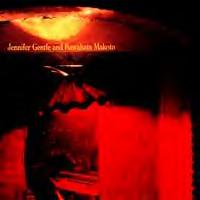 Jennifer Gentle's newest release is a live disc documenting a 2002 show in their native Italy during which they were joined on stage by the irrepressible Kawabata Makoto of Acid Mothers Temple. I'm not sure what, if anything, Makoto's monolithic acid-guitar stylings have in common with Jennifer Gentle's eclectic psych-pop. Perhaps nothing, but once the opening drones begin all such questions melt away.
Jennifer Gentle's newest release is a live disc documenting a 2002 show in their native Italy during which they were joined on stage by the irrepressible Kawabata Makoto of Acid Mothers Temple. I'm not sure what, if anything, Makoto's monolithic acid-guitar stylings have in common with Jennifer Gentle's eclectic psych-pop. Perhaps nothing, but once the opening drones begin all such questions melt away.
 Italian music listeners seem to have an enduring interest in rare psychedelic, progressive and kosmische music from the late 60's and 70's. There is a clutch of Italian labels like Akarma, Comet and Horizon that tirelessly pump out deluxe reissues of obscure chestnuts from America and Europe's recent rock past. Not surprisingly, a number of new groups have come out of Italy in the last few years that owe a tremendous debt to this tradition of psychedelic esoterica.
Italian music listeners seem to have an enduring interest in rare psychedelic, progressive and kosmische music from the late 60's and 70's. There is a clutch of Italian labels like Akarma, Comet and Horizon that tirelessly pump out deluxe reissues of obscure chestnuts from America and Europe's recent rock past. Not surprisingly, a number of new groups have come out of Italy in the last few years that owe a tremendous debt to this tradition of psychedelic esoterica.
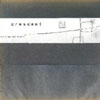 Comprised of members of both Movietone and Flying Saucer Attack,Crescent was born of the spacy post-rock scene that arose from Bristolin the mid-1990s. Vastly less interesting than either of those bands,Crescent has released a small handful of recordings since itsinception. Their latest, and first for Fat Cat, recalls the playfulorgan melodies and percussion of Pram; the slightly trippy, moody brassinflections of Legendary Pink Dots; and the mournful, jarring vocals ofJoy Division. This may sound like a great formula, but somehow Crescentjust doesn't pull it off. Overall, the raw, rough sound of By the Roads and the Fieldsmakes for a thought-provoking atmosphere, but ultimately does notcontribute anything to make the album compelling. The vocals of MattJones in particular tend to drag the music down. His monotone, sullenpresentation of the ponderous lyrics makes them far too heavy for thealbum's strong point, the sparse instrumentation. "Mica," the besttrack, seems to be so largely due to the fact that it doesn't havevocals on it. Devotees of Flying Saucer Attack and the subsequentprojects it spawned would be wise to wait for this fall's forthcomingMovietone record rather than pick up Crescent's latest offering.
Comprised of members of both Movietone and Flying Saucer Attack,Crescent was born of the spacy post-rock scene that arose from Bristolin the mid-1990s. Vastly less interesting than either of those bands,Crescent has released a small handful of recordings since itsinception. Their latest, and first for Fat Cat, recalls the playfulorgan melodies and percussion of Pram; the slightly trippy, moody brassinflections of Legendary Pink Dots; and the mournful, jarring vocals ofJoy Division. This may sound like a great formula, but somehow Crescentjust doesn't pull it off. Overall, the raw, rough sound of By the Roads and the Fieldsmakes for a thought-provoking atmosphere, but ultimately does notcontribute anything to make the album compelling. The vocals of MattJones in particular tend to drag the music down. His monotone, sullenpresentation of the ponderous lyrics makes them far too heavy for thealbum's strong point, the sparse instrumentation. "Mica," the besttrack, seems to be so largely due to the fact that it doesn't havevocals on it. Devotees of Flying Saucer Attack and the subsequentprojects it spawned would be wise to wait for this fall's forthcomingMovietone record rather than pick up Crescent's latest offering.


